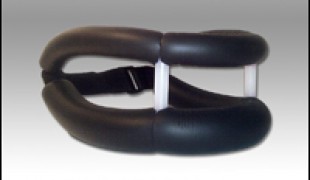- 7102
- 422
- 5
- 4
- 0
- Help Ukraine
About the solution
In 1993, he was riding his motorbike when he had an accident. When he was at the hospital, he had a CT scan that uncovered a brain tumor. The neurosurgeon said he needed an operation immediately as it might be malignant. Because of the tumor's position in the part of the brain that controls movement and conscious thought, Yaron knew he would probably survive the surgery but would suffer some cognitive dysfunction, develop epilepsy and could see half of his body become paralyzed.
The operation was a success, and after six months' recuperation, Yaron says he "felt an amazing victory and had no symptoms." The picture soon clouded, however, when he discovered 18 months later that the tumor was still there. When he returned to New York for another operation, the doctor told him no technology existed to remove such a deep-seated cancer. He was told to wait five years, and if he was lucky, someone would invent the technology.
What was needed was a smaller camera or scope that would allow the surgeon to see inside the brain in three dimensions and successfully remove the tumor. "What happens if no one invents this stupid camera? I felt so helpless. Even the best surgeon in the world couldn't save me. I had no hope. Trust me, it is not fun to live that way," Yaron said.
The will to live, combined with his innate curiosity, propelled Yaron to return to the library, this time to learn about visual perception, the way the brain is built, camera technology and stereoscopic vision. After two years of research, he thought he had guessed what the problem was. "I invented a solution. It was a single miniature silicon chip that could provide the proper image-processing algorithms."
Yaron says it was not actually his invention; he simply mimicked the way an insect eye works. Having left his job, Yaron filed some patents, scraped together $100,000, hired a physics Ph.D. and built a prototype to show the skeptics that his solution would work.
The solution came too early, according to Yaron, who said the world wasn't ready for 3D in 2008 and only with the release of the film "Avatar" a year later did the world embrace and accept 3D. "The technology works and saves thousands of lives globally now," he said.
More info: http://www.visionsense.com/
Adapted from: http://bit.ly/2fXPYj8
What about you, do you have any solutions? Please share them with the Patient Innovation community!
https://www.youtube.com/watch?v=YQqJ2ZuSMKg
这些解决方案不应包括使用药物,化学品或生物制品(包括食品);创伤性设备;冒犯性的,商业或内在危险的内容。该解决方案未经医学验证。请谨慎进行!如果您有任何疑问,请咨询健康专家。
DISCLAIMER: This story was written by someone who is not the author of the solution, therefore please be advised that, although it was written with the utmost respect for the innovation and the innovator, there can be some incorrect statements. If you find any errors please contact the patient Innovation team via info@patient-innovation.com
-
-
199
-
0
-
2985

CareAline® Sleeve and Wrap for patients with PICC and Central lines. We developed the CareAline® Sleeve...
CAREGIVING
(SELF)-CARE: HYGIENE: Maintaining personal hygiene
SLEEP FUNCTION: Resting
Cancer
Body-Worn solutions (Clothing, accessories, shoes, sensors...)
Promoting self-management
Manage Medication
Preserving Organ Function
Managing Neurological Disorders
To implement a diagnostic tool
To improve Treatment/Therapy
Preventing (Vaccination, Protection, Falls, Research/Mapping)
Caregiving Support
Intensive Care Medicine
Medical Oncology
Pediatrics
United States
-
-
-
173
-
0
-
2447

Humanizing therapies by accompanying patients through tailored 360/AR/VR experiences while in medical treatments
Grip
CAREGIVING
WALKING: Walking
WALKING WITH A WALKING AID: Walking with a walking aid
Social interaction
Covid19
5 Senses support devices: (glasses, hearing aids, headphones...)
Educational/Leisure device (book, toy, game...)
Treatment/Surgical device
Videogame
Strategy/Tip
Restoring mobility
Regaining sensory function
Improving respiratory function
Enhancing health literacy
Promoting self-management
Restoring heart health
Preserving Organ Function
Rehabilitating After Stroke
Managing Neurological Disorders
Building Supportive Community Relationships
Promoting inclusivity and social integration
Recovering from Traumatic Injuries
Enhancing Mental Health
Maintaining Balance and Mobility
Improving Speech and Communication
To improve Treatment/Therapy
Preventing (Vaccination, Protection, Falls, Research/Mapping)
Raise awareness
Caregiving Support
General and Family Medicine
Infectious Diseases
Internal Medicine
Physical Medicine and Rehabilitation
Pneumology
Spain
-
-
-
124
-
0
-
1874

shanesneckbrace
VENTILATION
WALKING: Walking
BODY BALANCE: Maintaining body balance
STANDING UP: Standing up from a seated position
SLEEP FUNCTION: Resting
CAREGIVING
Spinal Cord and Nerve Root Disorders
Treatment/Surgical device
Gait abnormalities (e.g., walking difficulties, unsteady gait)
Tremors
Muscle cramps or spasms
Stiffness or rigidity (difficulty moving)
Paralysis of the legs and lower body
Muscle weakness
Loss of balance
Numbness or tingling in the extremities
Fatigue
Managing pain
Promoting self-management
Preserving Organ Function
Managing Neurological Disorders
Recovering from Traumatic Injuries
Restoring Blood Circulation
To improve Treatment/Therapy
Preventing (Vaccination, Protection, Falls, Research/Mapping)
Neurology
Neurosurgery
Orthopedics
Physical Medicine and Rehabilitation
Rheumatology
Sports Medicine
United States
-
 zh
zh